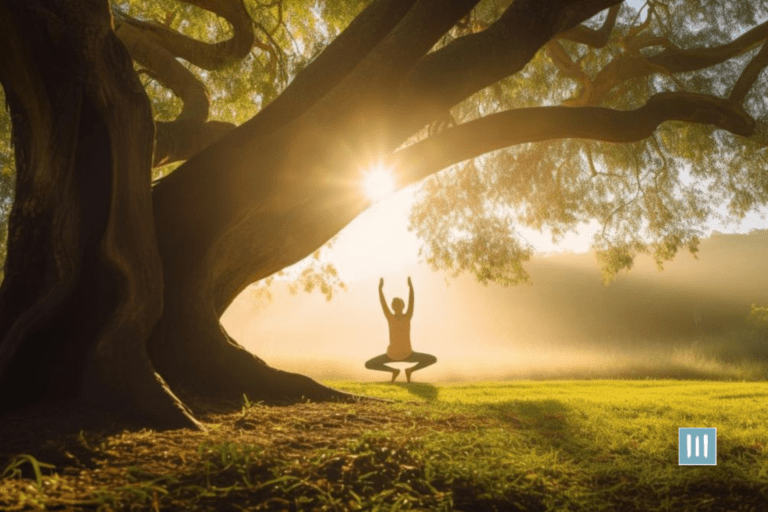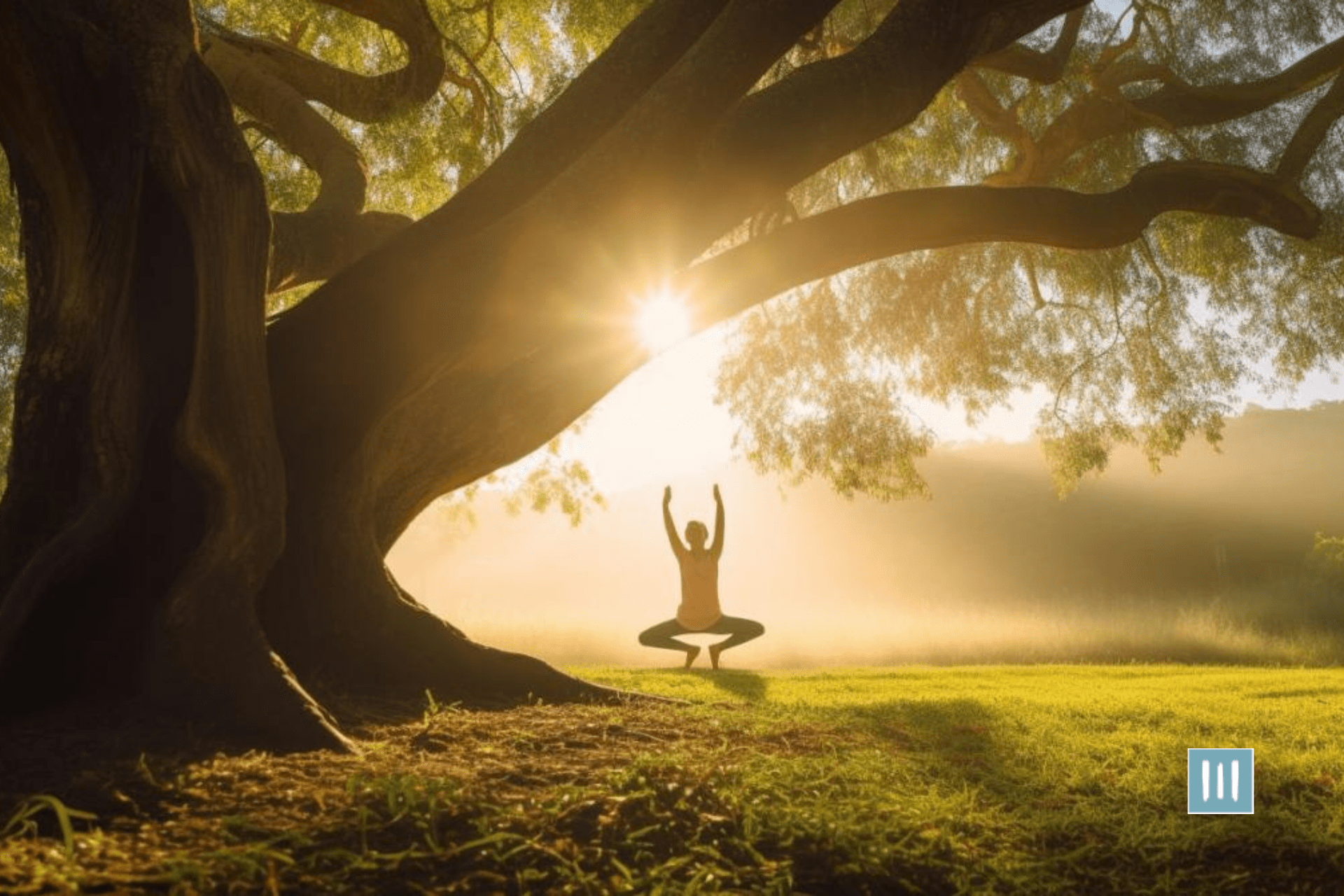In the fast-paced world we live in, it’s easy to feel overwhelmed and stressed. But what if I told you that there’s a powerful tool right at your fingertips that can help you find peace and balance in your life?
That tool is meditation, and when it comes to holistic fitness, incorporating meditation into your routine can work wonders for relieving stress and improving your overall well-being.
Meditation is not just about sitting in silence and clearing your mind. It’s a practice that connects the mind and body, allowing you to tap into your inner strength and find a sense of calm amidst the chaos.
By incorporating meditation into your fitness routine, you can experience a deeper level of relaxation, improved focus, and increased energy levels. So, if you’re looking to enhance your holistic fitness journey and find relief from stress, meditation may just be the missing piece of the puzzle.
Key Takeaways
- Meditation is a powerful tool for stress relief and overall well-being in holistic fitness.
- Practicing mindfulness, visualization, and loving-kindness meditation techniques can help in achieving inner balance.
- Starting with small meditation sessions and creating a sacred space can enhance the practice.
- Incorporating meditation into a fitness routine can effectively manage stress and improve physical and mental health.
Understanding the Mind-Body Connection
You know that understanding the mind-body connection is key to achieving holistic fitness, right? It’s not just about physical exercise and diet; it’s about recognizing how your thoughts and emotions impact your overall well-being.
When you practice mindfulness and meditation, you learn to listen to your body and understand its signals. This awareness allows you to make healthier choices and reduce stress levels, leading to a more balanced and harmonious life.
By acknowledging the interconnectedness of your mind and body, you can cultivate a sense of inner peace and resilience. When you take the time to quiet your mind through meditation, you create space for healing and renewal.
This practice not only reduces stress but also enhances your ability to cope with life’s challenges. So, next time you feel overwhelmed, remember the power of the mind-body connection and the positive impact it can have on your overall well-being.
Benefits of Meditation for Stress Relief
Engage in this practice regularly and notice a significant decrease in anxiety levels. Meditation has been proven to be a powerful tool for stress relief, allowing you to calm your mind and find inner peace amidst the chaos of daily life. By incorporating meditation into your routine, you can experience a sense of relaxation and rejuvenation that will positively impact your overall well-being.
Take a look at the table below to see some of the key benefits of meditation for stress relief:
| Benefits of Meditation for Stress Relief |
|---|
| Reduces anxiety and promotes relaxation |
| Enhances self-awareness and mindfulness |
| Improves emotional well-being and resilience |
By embracing meditation as a daily practice, you can tap into its transformative power and cultivate a sense of serenity that will help you navigate life’s challenges with grace and ease. Make time for yourself to meditate and watch as your stress melts away, leaving you feeling more balanced and centered.
Different Meditation Techniques
When exploring different meditation techniques, it’s important to remember that mindfulness, visualization, and loving-kindness can all be effective tools for relaxation and mental clarity.
- Mindfulness: Focus on being present in the moment, acknowledging thoughts and emotions without judgment, and returning your attention to your breath.
- Visualization: Picture a peaceful scene or positive outcome in your mind, engaging your senses to create a vivid mental image that promotes relaxation.
- Loving-Kindness: Direct feelings of love and compassion towards yourself and others, sending positive intentions and well wishes to cultivate a sense of connection and empathy.
By incorporating these different meditation techniques into your daily routine, you can discover which method resonates most with you and effectively helps you manage stress and promote overall well-being.
Remember, the power of meditation lies in your willingness to explore and practice with an open heart, allowing yourself to experience the transformative benefits of these ancient practices.
Incorporating Mindfulness into Daily Life
Embrace the present moment and let mindfulness become second nature in your daily routine, adding a new layer of peace to your life. Start your day with a few minutes of mindful breathing, focusing on the sensation of each inhale and exhale. As you go about your day, bring your attention to the task at hand, fully immersing yourself in the present moment. Whether you’re washing dishes, taking a walk, or having a conversation, practice being fully engaged in the experience.
To help you incorporate mindfulness into your daily life, here are a few simple practices you can try:
| Practice | Description |
|---|---|
| Mindful Walking | Pay attention to each step, feeling the ground beneath your feet and the movement of your body. |
| Mindful Eating | Slow down and savor each bite, noticing the flavors, textures, and sensations of the food you’re eating. |
| Mindful Breathing | Take a few moments to focus on your breath, observing the rise and fall of your chest or the sensation of air passing in and out of your nostrils. |
| Mindful Listening | Give your full attention to the person speaking to you, without planning your response or getting distracted by other thoughts. |
Incorporating these practices into your daily routine can help you cultivate a greater sense of calm and presence in your life. Remember, mindfulness is not about perfection, but about creating small moments of awareness and peace throughout your day.
Incorporating Meditation into Your Fitness Routine
Experience the incredible benefits of incorporating mindfulness practices into your daily workout routine.
As you lace up your sneakers and prepare for your next sweat session, take a moment to center yourself through meditation. Begin by finding a quiet space, closing your eyes, and focusing on your breath. Allow any stressful thoughts to melt away as you bring your attention to the present moment.
By practicing mindfulness before your workout, you’ll enhance your overall experience and set a positive tone for the rest of your day.
As you move through your fitness routine, continue to weave moments of meditation into your exercises. Whether you’re lifting weights, running on the treadmill, or practicing yoga, take breaks to check in with your breath and body. Notice any tension or stress that may be lingering and use your practice of mindfulness to release it.
By incorporating meditation into your fitness routine, you’ll not only strengthen your body but also nourish your mind and spirit. Embrace this holistic approach to wellness and watch as your stress levels decrease and your overall well-being flourishes.
Tips for Successfully Implementing Meditation Practices
Implementing meditation practices successfully involves finding a routine that fits seamlessly into your daily life. To help you achieve this, here are three tips to guide you along the way:
- Start Small: Begin with just a few minutes of meditation each day and gradually increase the duration as you become more comfortable with the practice. Remember, consistency is key, so find a time that works best for you and stick to it.
- Create a Sacred Space: Designate a peaceful area in your home where you can meditate without distractions. This space should be comfortable, quiet, and free of clutter, allowing you to fully immerse yourself in the practice.
- Stay Open-Minded: Approach meditation with an open heart and mind, without any preconceived notions or expectations. Embrace the process as a journey of self-discovery and personal growth, allowing yourself to let go of stress and connect with your inner peace. By following these tips, you’ll be well on your way to successfully implementing meditation practices into your daily routine.
Discover a personalized approach to weight management with Minimal’s tailored program, designed to suit your unique biology and lifestyle.
Frequently Asked Questions
Can meditation help with physical health conditions, such as chronic pain or autoimmune disorders?
Yes, meditation can help alleviate physical health conditions like chronic pain and autoimmune disorders. By calming the mind and reducing stress, meditation can promote healing and enhance overall well-being, providing relief from symptoms.
Is there a recommended time of day to practice meditation for optimal stress relief benefits?
For optimal stress relief benefits, meditating in the morning can decrease cortisol levels by 23% throughout the day. Start your day with a calming practice to set a positive tone and promote a sense of peace.
Are there any potential negative side effects of meditation, and how can they be avoided?
Potential negative side effects of meditation include increased anxiety or disturbing memories. To avoid these, start with short sessions, practice proper breathing techniques, and seek guidance from a qualified instructor. Remember to listen to your body’s needs.
Can meditation be effective for children and teenagers dealing with stress and anxiety?
Absolutely! Meditation can be incredibly effective for children and teenagers dealing with stress and anxiety. It helps them develop coping mechanisms, improve focus, and cultivate a sense of calmness amidst life’s challenges.
How can someone stay motivated and consistent with their meditation practice over the long term?
To stay motivated and consistent with meditation long term, set a routine, start small, celebrate progress, and find a supportive community. Remember, the benefits extend beyond yourself; by cultivating inner peace, you can better serve others.

















